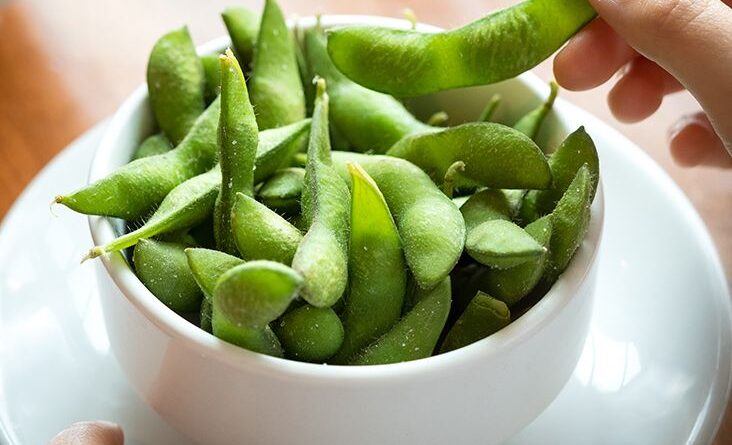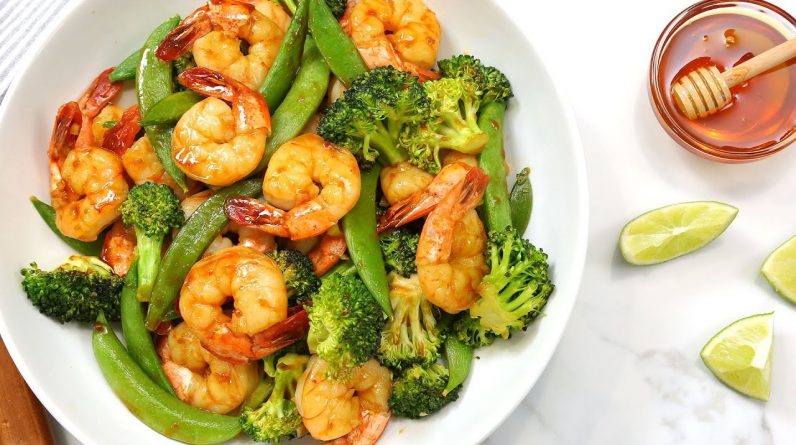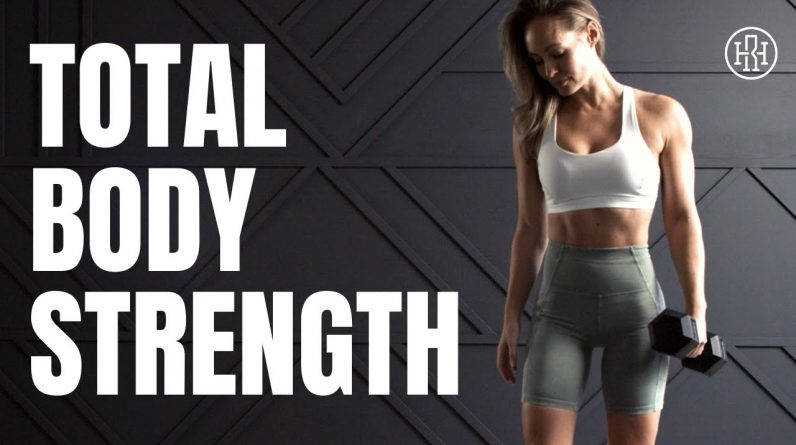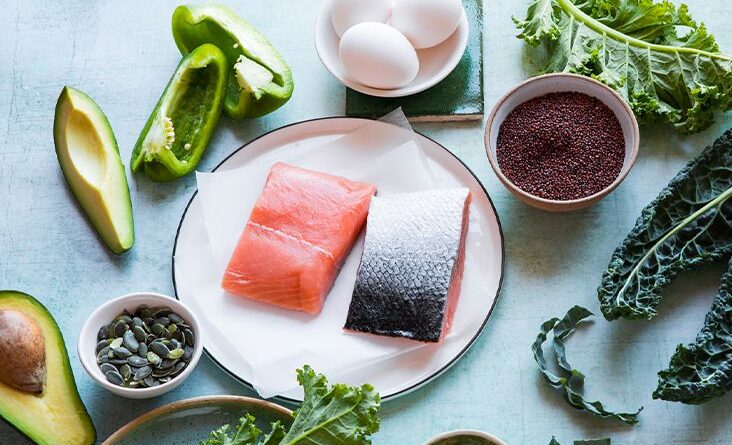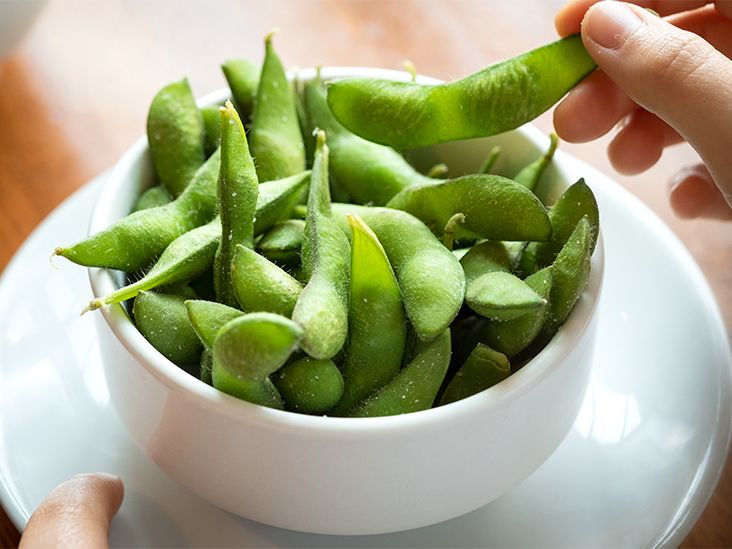
If you live a busy lifestyle, snacks can be useful when hunger hits and you don’t have time to prepare a meal.
However, many snack foods available today are high in refined carbs and sugar, which can leave you feeling unsatisfied and craving more food.
The key is to make sure your snacks are nutritious and contain protein.
Protein promotes fullness because it signals the release of appetite-suppressing hormones, slows digestion, and stabilizes your blood sugar levels (1, 2, 3, 4).
Many foods contain protein. Foods sourced from animals — such as meat, seafood, eggs, and dairy — tend to be highest in protein.
Plant foods such as nuts, beans, and legumes contain varying amounts of protein. But if you follow a vegan or vegetarian diet, eating a variety of plant-based proteins throughout the day can help you meet your protein needs.
Plus, eating protein from a variety of sources is good for your health. According to the U.S. Department of Agriculture, many people in the United States would benefit from shifting their protein intake to include more seafood and plant sources (5).
Here are 30 protein-loaded snacks that are healthy and portable, so you can enjoy them even when you’re on the go.
Jerky is meat that has been trimmed of fat, cut into strips, and dried. It makes an excellent and convenient snack.
It’s very high in protein — for example, beef jerky contains an impressive 9 grams (g) of protein per ounce (28 g) (6).
Beef, chicken, turkey, and salmon are often made into jerky. It can be found at most grocery stores, but keep in mind that store-bought versions are typically high in added sugar and artificial ingredients.
Your best bet is to make your own jerky, using only meat and some seasonings.
Trail mix is a combination of dried fruit and nuts and also sometimes includes chocolate and grains. It’s a good source of protein, providing 8 g in a 2-ounce (oz) serving (7).
You can increase the amount of protein in trail mix by using almonds or pistachios, which are slightly higher in protein than other types of nuts, such as walnuts or cashews (8, 9, 10, 11).
The dried fruit and nuts in trail mix make it very high in calories, so it’s important to not eat too much at a time. A handful is a reasonable serving.
Turkey roll-ups are a delicious and nutritious high protein snack consisting of cheese and veggies wrapped inside slices of turkey breast.
They’re like a sandwich without the bread.
Snacks that are high in protein and low in carbs, such as turkey roll-ups, have been shown to improve blood sugar levels, which is an important factor in appetite regulation (12, 13, 14).
You can make roll-ups by placing a slice of turkey breast on a plate; topping it with a slice of cheese, such as cheddar; placing a pickle or strip of cucumber and a tomato slice on top; and rolling everything into a wrap.
Each wrap provides about 12 g of protein from the turkey and cheese, as well as some extra nutrients and fiber from the tomato and cucumber (15, 16).
Greek yogurt is an ideal healthy and high protein snack, with 20 g of protein per 200-g serving. It has been shown to be more filling than yogurts with lower protein content (17, 18).
In addition to being a great source of protein, Greek yogurt is high in calcium, which is important for bone health (19).
To make yogurt even more delicious and filling, you can make a parfait by combining 1 cup of yogurt with granola and mixed berries in layers.
Adding 1/2 cup (49 g) of granola to your yogurt can provide 4 g of protein or more. But this makes a large snack that’s high in calories, so you may not want to snack on this every day, depending on your overall calorie needs (20).
Veggies are great for snacking, but they’re not very high in protein on their own. You can increase your protein intake by pairing them with yogurt dip.
Yogurt dip is typically made by combining yogurt with herbs and flavorings, such as dill and lemon juice, as in this recipe. For more protein, it’s best to use Greek yogurt, which contains almost twice as much protein as regular yogurt (17, 21).
A 100-g portion (1/3–1/2 cup) of Greek yogurt contains 10 g of protein (17).
For convenience, you can make a batch of yogurt dip ahead of time and portion it out into snack-size containers so you can grab it when you need it.
Tuna is loaded with protein and makes a very healthy and convenient snack. A 3-oz serving of canned tuna contains an impressive 20 g of protein, which makes it extra filling (22).
Additionally, tuna is high in various other nutrients, such as B vitamins and selenium, and contains a considerable amount of omega-3 fatty acids (22).
Eggs are undeniably healthy, containing almost every nutrient your body needs. They’re particularly high in B vitamins and trace minerals (23).
In addition to being nutritious, they’re versatile. Hard-boiled eggs make a great portable snack.
One hard-boiled egg provides 6 g of protein, which will keep you full and satisfied until your next meal. The fullness-promoting properties of eggs may also reduce the number of calories you consume later in the day (23, 24).
Celery sticks spread with 1–2 tablespoons (tbsp.) of peanut butter make a delicious and easy snack. They contain a decent amount of protein from the peanut butter, which provides 9 g of protein per 2-tbsp. (30-g) serving (25).
Peanut butter and peanuts are known for helping you feel full and have been shown to promote feelings of fullness when consumed between meals (26, 27).
In one small, older study, participants found peanut butter more filling than whole nuts such as almonds or chestnuts (26).
Energy bites are a delicious snack made by combining a variety of ingredients, such as nut butter, oats, and seeds, and then rolling them into balls.
The best part about energy bites is that they don’t require baking. You can make a batch ahead of time so you have a snack available when you need to grab one and go.
Here is a recipe for chocolate chip energy balls, which provide 4 g of protein per ball.
If you include protein powder in your diet, consider trying a recipe that uses it. This recipe for peanut butter energy bites bumps up the protein to more than 6 g per ball.
In addition to being a quick and easy snack, cheese is incredibly healthy and filling. It’s an excellent source of calcium, phosphorus, and selenium, and it contains small amounts of many other nutrients (16).
Furthermore, cheese is rich in protein. Just one slice of cheddar cheese provides 7 g of this nutrient, which may help you feel less hungry (16, 28).
In one study in overweight men, calorie intake decreased by 9% after the participants consumed cheese for a snack (28).
Another study found that children who ate a combination of cheese and vegetables for a snack needed significantly fewer calories to make them full than those who ate potato chips (29).
A reasonable portion size for cheese is around 1–2 oz (28–57 g). Since it contains a significant number of calories, it’s best consumed in moderation.
Eating a handful of almonds or another type of nut for a snack is a simple way to fill up on protein.
One ounce of almonds provides 6 g of protein, along with good amounts of vitamin E, riboflavin, trace minerals, and healthy fats (8).
Snacking on almonds regularly is associated with many other health benefits and may even help you manage your weight (30, 31).
Almonds are also high in calories, so it’s important to stick with the recommended serving size. A handful is equivalent to around 22 almonds.
Chickpeas, or garbanzo beans, are a legume with an impressive nutrient profile. They’re also an excellent source of fiber.
As a source of plant-based protein, chickpeas are a great snacking option for those following a vegetarian or vegan diet.
One half-cup (82 g) of cooked chickpeas contains 7 g of protein and 6 g of fiber, in addition to many vitamins and minerals. They’re particularly high in folate, iron, magnesium, phosphorus, copper, and manganese (32).
The combination of fiber and nutrients in chickpeas may help reduce the risk of several health conditions, such as heart disease, type 2 diabetes, and some cancers (33).
One tasty way to prepare chickpeas for a snack is to roast them with some basic seasonings and olive oil. Roasted chickpeas are crunchy and portable, so you can take them with you and enjoy them when hunger hits.
Tofu is a rich source of protein. While it’s particularly known for being vegan- and vegetarian-friendly, tofu is a healthy protein source to enjoy in any diet (34).
Tofu is made from soybeans that have been ground, cooked, and pressed to produce a solid curd (34).
A 3-oz (84-g) serving of firm tofu contains 9 g of protein, which makes it a filling snack (35).
Cubes of baked tofu are easy to pack up and enjoy on the go. Try this recipe for baked tofu that’s tossed in vegetable oil and seasoning for a crispy coating.
Cottage cheese is known for being high in protein. It’s a filling snack that can be eaten on the go.
A half-cup (113 g) of cottage cheese has 14 g of protein, which makes up 69% of its total calorie content (36).
Cottage cheese is also a good source of other important nutrients, including calcium, phosphorus, selenium, vitamin B12, and riboflavin (36).
You can enjoy cottage cheese on its own or combine it with fruits and nuts for a delicious snack.
Apples and peanut butter taste great together and make for a nutrient-dense, high protein snack that provides many health benefits.
The fiber and antioxidants in apples may improve gut health and reduce the risk of heart disease, while peanut butter has been shown to increase HDL (good) cholesterol and reduce LDL (bad) cholesterol and triglycerides (30, 37, 38, 39).
Despite the positive effects peanut butter may have on your health, it’s fairly high in calories, so it’s best consumed in moderation.
A snack of a medium apple with 2 tbsp. (30 g) of peanut butter provides 9 g of protein, as well as some other nutrients, such as vitamin C and potassium (25, 40).
When enjoying a slice of watermelon, you might be in the habit of eating around the seeds.
As it turns out, those seeds contain protein, zinc, and iron. They can be roasted to make a crunchy, satisfying snack (41).
Roasted watermelon seed kernels contain about 8 g of protein per ounce (28 g) (42).
You can roast your own watermelon seeds in the oven or buy them pre-roasted.
Watermelon seed butter is a spread you can purchase to use in place of nut butter in snacks or recipes.
Protein bars are an easy way to consume a significant amount of protein.
However, many store-bought versions are high in added sugar or sweeteners and other unnecessary ingredients.
You can make a batch on your own by following this recipe, which uses seeds, dried fruit, and protein powder. Each of these bars contains 9 g of protein. You can skip the chocolate topping if you want a lighter snack.
If you prefer to buy protein bars, consider choosing healthier options with minimal additives.
Canned salmon is an excellent high protein snack that you can take with you wherever you go. Just 1 oz (28 g) provides more than 6 g of protein as well as other nutrients, including niacin, vitamin B12, and selenium (43).
Salmon also provides omega-3 fatty acids, which are anti-inflammatory and may lower your risk of heart disease, depression, and dementia (44, 45, 46).
You can eat canned salmon on its own or add some extra flavor with a little bit of salt and pepper. It tastes great when paired with crackers or chopped veggies.
Single-portion pouches of cooked salmon are available to make it easier to pack salmon with you on the go.
Chia pudding has become a popular snack in recent years — and for good reason. In addition to being high in protein, it’s delicious and healthy.
There are 4 g of protein in 1 oz of chia seeds, and they provide some other nutrients, such as calcium, phosphorus, and manganese (47).
Moreover, they’re notable for their high omega-3 fatty acid content, which provides several health benefits (48).
For example, snacking on chia seeds may help lower your triglyceride levels, which can help reduce your risk of heart disease (49).
To make a protein-rich chia pudding, use cow’s milk or a high protein milk alternative such as soy milk. One cup (240 milliliters) of cow’s milk adds 8 g of protein to your pudding, while soy milk adds about 7 g, depending on the brand (50, 51).
Soak chia seeds in milk for a few hours until it reaches a pudding-like consistency. You can add flavorings such as vanilla and cocoa, as in this recipe. For an extra treat, you can make the caramel topping included in the recipe or simply top off the pudding with some fruit.
Granola is a baked snack that consists of rolled oats, nuts, and a sweetener such as honey. Many store-bought granolas provide some protein — about 4 g per 1/2-cup (49-g) portion. But they also tend to be very high in sugar and calories (20).
To get more protein and less sugar in your granola, you can make your own version at home. All you have to do is bake oats, nuts, and seeds together, such as in this recipe. The recipe features protein powder for an extra boost, offering 9 g of protein per 1/3 cup of granola.
Although it’s healthy in moderation, granola can be high in calories. A 1/3-cup serving of the version above can provide almost 300 calories, so it’s easy to overdo it. Consider using granola in small amounts to garnish a cup of yogurt or berries.
Pumpkin seeds are great for a quick snack, and they contain protein and some other valuable nutrients.
One ounce (28 g) of pumpkin seeds contains 5 g of protein and significant amounts of fiber, magnesium, zinc, and polyunsaturated fatty acids. These seeds also provide disease-fighting antioxidants, including vitamin E and carotenoids (52).
Some evidence suggests that eating pumpkin seeds may help prevent certain cancers, while their healthy fat content may benefit heart health (53, 54).
Furthermore, their protein and fiber content makes them a great snack to curb hunger until you’re able to eat a full meal. You can eat them raw or try roasting them with some spices.
Nut butter is a good option when you need a quick and portable high protein snack.
In the United States, you can find single-serving nut butter packs in the nut butter section or checkout lanes of many grocery stores.
You can also scoop your preferred peanut butter or almond butter from the jar into small to-go containers.
Nut butters are quite nutrient-dense, providing a significant amount of healthy fats, B vitamins, vitamin E, magnesium, phosphorus, and trace minerals. A 2-tbsp. (30-g) serving of peanut butter contains 9 g of protein (25).
While getting your protein from whole food sources is ideal, protein shakes make for an easy snack that will sneak some protein and other nutrients into your diet.
You can make these with any of several types of protein powder, including whey, egg white, soy, and pea protein.
Whey protein, in particular, may be beneficial for fullness. In one small study, men who ate a snack bar that contained whey protein consumed significantly fewer calories than those who ate a lower protein snack (13, 55).
In another small study, a snack of yogurt with added whey protein reduced appetite more than a carb-rich snack with the same number of calories (56).
Generally, a scoop of protein powder provides 20–25 g of protein, which is sure to keep you full until your next meal (57).
To make a protein shake, you can simply blend together 1 scoop of protein powder, 1 cup of water or milk, 1 cup of ice, and fruit, if desired. Then pour it into a portable container so you can take it with you wherever you go.
Edamame beans are immature soybeans that are still in the pod. They’re high in protein, vitamins, and minerals and make for a quick and easy snack.
One cup of edamame provides some of just about every nutrient you need, including 18 g of protein and large amounts of vitamin K and folate (58).
Typically, edamame is served as a steamed dish. Many stores offer precooked and frozen edamame that need to be heated in a microwave. All you have to do is place the heated edamame in a portable container so you can enjoy it on the go.
To enhance the flavor of edamame, add spices and seasonings of your choice.
Though they’re not a well-known food in the United States, canned sardines are a convenient and nutritious snack.
These small fish are rich in protein, calcium, and other nutrients. One Pacific sardine (38 g) contains 8 g of protein (59).
The omega-3 fatty acids found in sardines can help protect your cardiovascular health and reduce inflammation in your body (60).
People describe their flavor as salty and slightly fishier than tuna. Many people enjoy them straight from the can, on a cracker, or in Mediterranean-style cooking.
Quinoa is a grain-like food that’s gluten-free and a good source of protein, vitamins, and minerals (61).
One cup of cooked quinoa contains 8 g of protein (62).
The chewy, nutty grains can be enjoyed as a side dish like rice. You can also add a scoop of quinoa to a salad of greens and chopped vegetables.
For a quick snack, try eating cooked quinoa as you would a hot cereal, topped with cinnamon and a drizzle of honey.
A lentil salad is a great snack. It’s highly nutritious and a great plant-based source of protein. In fact, 1 cup of cooked lentils provides 18 g of protein, along with large amounts of iron, folate, and manganese (63).
In addition, lentils provide more than 50% of your recommended daily fiber intake. The specific type of fiber found in lentils may promote a healthy gut, as it helps feed the good bacteria in your colon (64).
The combination of protein, fiber, and carbs in lentils is especially helpful for promoting fullness, and consuming them regularly may help manage diabetes and reduce the risk of heart disease and some types of cancer (65, 66, 67).
To make lentil salad, combine cooked lentils with chopped veggies, spices, and a dressing of your choice. It tastes great when topped with balsamic vinegar and olive oil, such as in this recipe.
Overnight oatmeal is easy to make, portable, and very nutritious.
Oats are loaded with many vitamins and minerals. In addition, a 1-cup (234-g) serving provides about 15% of your recommended daily fiber intake (68).
Oats have been shown to promote fullness in several studies. This is likely due to their healthy fiber content (69, 70, 71).
In one small study in 2013, oats resulted in greater feelings of fullness and a reduced desire to eat when compared with ready-to-eat cereal with the same calorie content (69).
Another small study compared perceived hunger and food intake after consuming either oatmeal or oranges. The participants who ate oatmeal experienced less hunger immediately after eating and consumed less food later in the day (71).
However, oats are not very high in protein on their own. One-third cup of oats contains about 3 g of protein (68).
To turn oats into a protein-rich snack, you can make overnight oats with protein add-ins such as cow’s milk or soy milk, Greek yogurt, nut butter, and protein powder.
This overnight oats recipe boasts 37 g of protein per serving. To make a snack-size version, portion the overnight oats mixture into several small containers before chilling it overnight.
Egg bites are a super healthy snack with lots of protein.
You can make them by mixing eggs with veggies and seasonings, pouring the mixture into a muffin tin, and then baking it.
They’re also very convenient, as they can be eaten hot or cold. You can increase their nutrient content by making them with veggies and add more protein by topping them with 1–2 tbsp. of cheese.
This egg muffin recipe combines eggs with spinach, onions, and bell peppers.
Popcorn is a popular and healthy snack food that provides some B vitamins, magnesium, phosphorus, zinc, and manganese. It also contains a significant amount of fiber, with 4 g per ounce (28 g) (72).
In addition, some research suggests that popcorn is a particularly filling snack. In a small 2012 study, participants who snacked on popcorn were less hungry and ate less than those who snacked on potato chips (73).
Despite popcorn’s filling effects, it’s not incredibly high in protein on its own. You can significantly increase its protein content by adding nutritional yeast, which provides 5 g of protein per 2-tbsp. serving (74).
In addition to being a vegan-friendly source of protein, nutritional yeast adds an appealing cheese-like flavor. To enjoy “cheesy” popcorn as a snack, simply combine 3 cups of popcorn with 2 tbsp. of nutritional yeast and a pinch of salt.
Which snacks have the most protein?
Some high protein snacks include jerky made from chicken, turkey, salmon, or beef, smoked or canned fish, tofu, and Greek yogurt.
What are healthy high protein snacks for muscle gain?
Healthy snack options that are high in protein include Greek yogurt, hard-boiled eggs, lentil salad, and nut butter on apple slices.
What are easy high protein snacks for bodybuilding?
Easy high protein snacks for bodybuilding can include protein bars and shakes, jerky, and nuts like almonds.
High protein snacks are important to have around when hunger hits between meals, as they keep you full and satisfied.
While many snacks can be unhealthy, there are plenty of healthy and portable options that you can enjoy even when you’re crunched for time.



